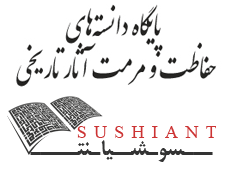حامد صیادشهری
مطالعهی فنی و مستندسازی نقاشیهای گنبدخانهی مزار شیخاحمد جامی
پایاننامهی کارشناسی ارشد،
دانشکدهی هنرهای کاربردی،
دانشگاه هنر، 1388
استاد راهنما: احمد صالحیکاخکی; صمد سامانیان
چکیده:
مجموعهی آرامگاهی شیخ احمد جامی در تربت جام خراسان واقع شده است. قدیمیترین بنای آن معروف به گنبدخانه در سال ۶۳۳ هـ.ق. ساخته شده و ساخت سایر بناها، تعمیرات، تغییرات و الحاقات بعدی تا دورهی قاجار و حتی معاصر ادامه داشته است. در این پایاننامه ابتدا بناهای موجود در این مجموعه معرفی شده و تزئینات بهکاررفته در بنای گنبدخانه بهویژه نقاشیهای آن شرح داده شده است. با مستندسازی، مطالعهی تطبیقی، استفاده از روشهای دستگاهی و مطالعهی میکروسکوپی مشخص گردید که نقاشیهای اصلی با تکنیک آبرنگی، بدون لایهی تدارکاتی و با رنگهای آبی لاجورد، سرنج، سبز زنگار و اخرا بر روی گچ کشته اجرا شده است. همچنین مشخص شد که مرمتهای اخیر بر اساس طرح اولیه و با رنگهای سودالیت، لیتارژ و یکی از ترکیبات منگنز انجام گردیده است. در نهایت با توجه به مستندسازی و مطالعهی آسیبها و میزان دخالتهای مرمتی، چالشهای پیش رو در حفظ و مرمت دیوارنگارههای مذکور بررسی شده و نگهداشتنِ نقوش مرمتی، تمیزکاری موضعی، استحکامبخشی لایهها و تثبیت رنگدانهها به عنوان راهکار مناسب حفاظتی و مرمتی ارائه و اجرا گردیده است.
Abstract: Shrine-complex of Shaikh Ahmad-i-Jami is in Torbat-i-Jam town, Khorassan. Although the oldest building of this complex is main dome (Gonbad Khaneh) which has been built in 633 A.H., other parts of tomb have been built, repaired, altered and appended until Qajar period or even later till now. Here in this essay, architectural structures of the complex have been introduced and then decorations of Gonbad Khaneh, particularly its wall paintings have been explained. On the other hand, documentation, comparative studies, instrumental analysis, and microscopic investigation of wall paintings have shown that the original paintings have been drawn with water-color of lapis lazuli, red lead, verdigris and red ochre on gypsum plaster without any preparation layer. Also, it was revealed that sodalite, litharge, manganese compounds are the pigments used in recent re-integrations. Finally, base upon documentation, pathology and ratio of interventions, challenges and problems encountered during restoration with respect to ethic codes and principles have been investigated. Preventive conservation, moreover, leaves recent integrations untouched, local cleaning and consolidation of paintings has been suggested and done as an adequate restoration method.
